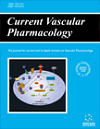-
oa Editorial [ Endothelial Dysfunction: Novel Therapeutic Approaches (Guest Editor: Dimitris Tousoulis)]
- Source: Current Vascular Pharmacology, Volume 10, Issue 1, Jan 2012, p. 2 - 3
-
- 01 Jan 2012
Abstract
During the last decade, it has been well documented that the vascular endothelium is not only a monolayer of endothelial cells (ECs) that lines the entire vascular system, but also it contributes actively to vascular homeostasis, inflammatory and immune responses [1]. More specifically, it has been found that endothelial cells exert significant autocrine, paracrine or endocrine actions and affect platelets, smooth muscle cells, as well as leucocytes. Also, it constitutes a crucial border between the circulation and the interstitium/cells, while regulating the vascular tone, inducing the production of several vasoactive substances including nitric oxide (NO), endothelin (ET), angiotensin II and endothelial-derived hyperpolarizing factor (EDHF) [2, 3]. Therefore, it is obvious that endothelial dysfunction plays a key role in the progress of atherosclerosis. Studies have reported that a several factors-conditions including hyperlipidemia, hypertension, hyperhomocysteinemia, smoking, diabetes mellitus, and genetic factors predispose to endothelial dysfunction (ED) [4-6]. Additionally, novel risk factors have been determined the last years that are closely related to the incidence and prevalence of cardiovascular disease. Among others, C-reactive protein, homocysteine, and myeloperoxidase, have gained wide interest [7-9]. Whilst these biomarkers derive from very different pathways, they all affect the normal endothelial function. Beyond that, asymmetrical dimethylarginine (ADMA) has evolved as an important regulator of NO synthesis and is the first cardiovascular biomarker that acts primarily by impairing NO-mediated endothelial function [8]. Asymmetrical dimethylarginine thus is a marker that may be useful during the early stages of atherosclerosis. Moreover, considering the fact that endothelial dysfunction is a major mechanism participating in all the stages of atherosclerosis requires an in depth, evaluation of endothelial function as it appears to have a predictive role in humans [2], and therapeutic interventions improving nitric oxide bioavailability in the vasculature, may improve the long-term outcomes in healthy individuals, high-risk subjects or patients with advanced atherosclerosis. Therefore, several therapeutic strategies have been investigated and proposed to targeting both the synthesis and production of NO in human vasculature. The first paper by Tousoulis et al. [10] is an introductory one, discussing thoroughly the role of nitric oxide in ED, highlighting associated pathways and mentioning the need for therapeutic approaches improving vascular function….


